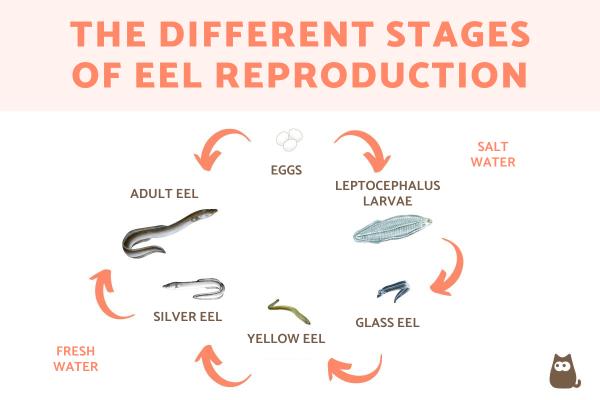How Do Eels Reproduce?


Eels are fish making up the order Anguilliformes, a type of ray-finned fish that are known for their long bodies. Despite all eel species having certain similarities, they are a very diverse order of fish. While most eels live in marine ecosystems, some species move between marine and freshwater environments. Some have spotted markings, others are solid in color. You may have heard that some eels have the ability to produce electricity, but electric eels are not actually in the eel order. True eels resemble a cross between a fish and a snake, but they all have certain habits which they share. Eel reproduction is an important one.
At AnimalWised, we discover how do eels reproduce? We look at the stages of eel reproduction, explaining their complex reproductive system and providing diagrams to better understand this process.
Do eels reproduce sexually or asexually?
Eels carry out a type of sexual reproduction which requires external fertilization. In this way, the females release the eggs into the water. When they do so, males expel their sperm into the water. This means there is no physical connection between males and females during the mating act. This process occurs in a spawning ground where the breeding occurs and fertilization happens outside of the female.
This type of eel reproduction means they are oviparous animals. This means the eggs are not only fertilized outside the body, but the eggs develop on their own. This is one of the mechanisms of oviparity. In other oviparous animal species, fertilization is internal, but the development of the egg also occurs outside the mother.
Discover more with our article explaining what are oviparous animals?
Eel reproduction stages
Eel reproduction is a complex process which requires various stages until completion. The reproductive process in eels has been subject of study for ichthyologists for many years, but there are still several aspects which are either unknown or poorly understood. This is because it is difficult for us to observe them during each phase of reproduction. Depending on the type of eel, some can live as adults in fresh water and reproduce in marine spawning grounds, while others live in salt water and spawn in freshwater environments.
With this in mind, we can take a look at the different stages of eel reproduction:
- Egg: eels begin life in the form of an egg that has been fertilized. There are no exact records of how long this phase lasts. Depending on the type of eel, they may be free-living eggs or attached to a certain substrate. They are generally larger eggs than those commonly found in other fish, measuring between 1 and 4 mm. The amount of eggs a female can lay varies, but some can lay thousands of eggs at a time.
- Larva: eel larvae hatch from the eggs. This larval form in which they are born is known as leptocephalus, literally meaning ‘slim head’. In eels and other fish species, these larvae are characterized by having a flat, transparent shape and containing a gelatinous substance in inside. In this phase, the eels feed on particles suspended in the water. These are usually suspended organic particles known as marine snow. The size is usually between 2-4" (5-10 cm), but some reach as much as 122 (30 cm). This stage of ell reproduction can last between 3 months to about a year.
- Glass eel: after the larval stage, eel larvae go through a process of metamorphosis. After this time they are known as glass eels, a more developed stage. For example, their teeth are now present. Although they are still crystalline, the pigmentation process begins. The species that were in the sea travel to the estuaries and then enter fresh water during this phase.
- Yellow eel: the name of this stage of eel reproduction is due to the coloration that begins to tone at the ventral level. By this time, the eel has already traveled to what will be its definitive habitat as an adult. For example, those of the genus Anguilla move upstream.
- Silver eel: the final stage before becoming an adult eel. After some time in this phase, they then make the return trip to start the cycle again. Here the final pigmentation of the eel's skin occurs.
Learn more about eel skin with our article explaining whether all types of fish have scales.

When do eels reproduce?
Depending on the type of eel, they spend their adult life stage in rivers, lakes or in the sea. Many of them spawn in bodies of water different from where they spend their lives as adults. Identifying eel spawning sites has been a challenge for scientists. It was only relatively recently that these areas were identified by species.
Eels spend time as adults preparing to reproduce. They do not usually reproduce immediately, even if they have matured sexually. Eels are a fish species that commonly only reproduce once in their lives. In most cases, after managing to reproduce, the eel will die.
The stage of their lives during which an ell will reproduce depends on several factors. For example, it is common for them to wait until they have the appropriate conditions before migrating for reproductive purposes. Some of these conditions include:
- Reaching their full developmental size
- Having sufficient body reserves
- Waiting for appropriate water temperature
- Prey availability
- A good flow of water when they are going to move in aquatic bodies such as rivers
It has been suggested that certain species of eels such as Japanese eels (Anguilla japonica) synchronize their spawning with the new moon. Migrations are also reported to occur with a full moon, when the tides rise. Waiting for this to happen better facilitates the movement of these fish.
The specific reproduction times in eels are variable. Some are little known. It is a complex and long process that does not occur punctually as in other species. An eel's migratory journey can last more than a year. Different species that live as adults in different bodies of water migrate to their spawning ground, but this can happen at different times of year. For example, European eels do this in July, while American eels do it around February or April.
Learn more about how the type of water affects fish species with our article on the different types of freshwater fish.
How are eels born?
As we have mentioned, eels are born or hatch from fertilized eggs. When they emerge they form a type of leptocephalus larvae called which develop in incremental stages. As the eel larvae develop, they carry out the process of metamorphosis. This allows different structures to develop such as their teeth, fins and eyes. Eventually, they will develop the complete bone structure of a fully-formed adult eel. Eels have a spine, making them types of vertebrate animals.
Learn more about the animals that go through metamorphosis in our related guide.
If you want to read similar articles to How Do Eels Reproduce?, we recommend you visit our Facts about the animal kingdom category.
- David, S. (2000). Anguilla rostrata. Animal Diversity Web. Retrieved from: https://animaldiversity.org/accounts/Anguilla_rostrata/
- Skupin, M. (2006). Anguilla. Animal Diversity Web. Retrieved from: https://animaldiversity.org/accounts/Anguilla_anguilla/
- Tsukamoto, K., Otake, T., Mochioka, N., et al. (2003). Seamounts, New Moon and eel Spawning: The Search for the Spawning Site of the Japanese eel. Environmental Biology of Fishes, 66, 221–229. https://doi.org/10.1023/A:1023926705906






